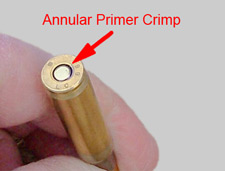Home | Glossary | Resources | Help | Contact Us | Course Map
Archival Notice
This is an archive page that is no longer being updated. It may contain outdated information and links may no longer function as originally intended.
Centerfire Ammunition
Rifle and handgun ammunition differ primarily in cartridge length. Other than selecting a machine with an appropriate stroke length, the loading operations are nearly identical.
Case Mouth Sealant
If the cartridge is to be sealed to prevent moisture infiltration around the bullet, a sealant must be applied to the inside of the case mouth before beginning other loading operations. Traditionally, the preferred sealant was a black asphaltic tar. It was applied wet and set aside for drying and curing. Once the sealant dried, the frictional heat of bullet seating partially remelted the tar, ensuring a good seal.
Today, manufacturers are using newer synthetic materials that can be applied and flash dried before loading.
Priming
Cases that do not have a flashhole opened during case manufacture are candidates for off-line priming using the pierce-and-prime machine. Cases are fed into a large rotating dial that grips each case firmly and moves it through the priming process. The workstation is fitted with a heavy-duty sharp punch beneath the dial. As the case stops at the station, a hollow backer punch enters the case to hold it down and the sharp punch moves up. It strikes the center of the primer pocket and produces a flashhole of the correct diameter. Both punches are withdrawn and the case moves to the next workstation.
After the operator has confirmed that the case is ready, it moves to a priming station. The case is still seated upright in the dial. Primers are fed through a magazine to a position directly under the case. A lower punch rises, picks up a primer, and pushes it into the case while a backer punch enters the case mouth to provide support for accurate seating.
After priming, a sealant is added to the narrow circular depression formed where the primer meets the case. A single drop of liquid acetate or other suitable material is applied to one side of the pocket; capillary action wicks the liquid to fill the depression.
In addition to being sealed, military ammunition primers used in semiautomatic rifles or fully automatic weapons must be further secured in place beyond the usual frictional fit by annular crimping or staking. Without such measures, chamber pressures may force the primer backward out of position causing the weapon to malfunction.
Annular primer crimps alter the entire edge of the primer pocket. A hollow steel tube, slightly larger than the primer pocket, is centered over the pocket and force is applied. The resulting rim of brass that overhangs the primer ensures a secure lock.
Staking accomplishes the same purpose in a different way. Three small indentations spaced 120 degrees apart surround the primer pocket in the base of a cartridge case containing the primer. Staking can be observed in some forms of foreign military ammunition.
Propellant Charging
As with rimfire ammunition, centerfire charging methods depend on the machinery used. More high-speed continuous loading machines are used, forcing the adoption of sophisticated propellant meters. The sliding powder measure is capable of handling faster production rates. Lower-volume cartridge production is still performed on slower interrupted sequence machines.
Most centerfire loading operations include inspection immediately after the charging station. A pin will drop into the case, determining if the volume of propellant is out of specification. Electronic or mechanical sensors read the position of the pin.
Additional Online Courses
- What Every First Responding Officer Should Know About DNA Evidence
- Collecting DNA Evidence at Property Crime Scenes
- DNA – A Prosecutor’s Practice Notebook
- Crime Scene and DNA Basics
- Laboratory Safety Programs
- DNA Amplification
- Population Genetics and Statistics
- Non-STR DNA Markers: SNPs, Y-STRs, LCN and mtDNA
- Firearms Examiner Training
- Forensic DNA Education for Law Enforcement Decisionmakers
- What Every Investigator and Evidence Technician Should Know About DNA Evidence
- Principles of Forensic DNA for Officers of the Court
- Law 101: Legal Guide for the Forensic Expert
- Laboratory Orientation and Testing of Body Fluids and Tissues
- DNA Extraction and Quantitation
- STR Data Analysis and Interpretation
- Communication Skills, Report Writing, and Courtroom Testimony
- Español for Law Enforcement
- Amplified DNA Product Separation for Forensic Analysts



